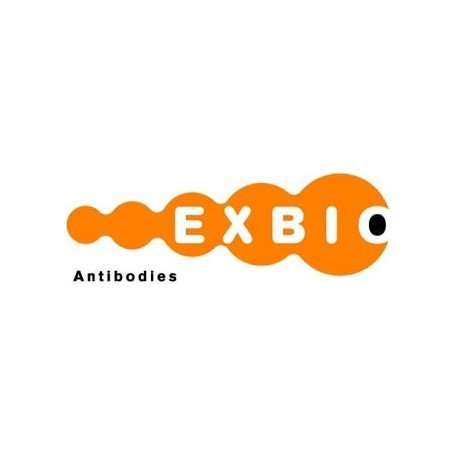Cart 0 Product Products (empty)
No products
To be determined Shipping
0,00 € Total
Prices are tax excluded
Product successfully added to your shopping cart
Quantity
Total
There are 0 items in your cart. There is 1 item in your cart.
Total products (tax excl.)
Total shipping (tax excl.) To be determined
Total (tax excl.)
Data sheet of Mouse Monoclonal to CD111 / Nectin-1
| Brand | Exbio |
| Product type | Primary antibodies |
| Reactivity | Human |
| Clonality | Monoclonal |
More info about Mouse Monoclonal to CD111 / Nectin-1
| Brand: | Exbio |
| Product no.: | 11-780-C025 |
| Product type: | Primary antibodies |
| Host species: | Mouse |
| Product name: | Mouse Monoclonal to CD111 / Nectin-1 |
| Antigen: | CD111 |
| Clonality: | Monoclonal |
| Clone: | R1.302 |
| Isotype: | IgG1 |
| Immunogen: | NIH/3T3 cells transfected with human CD111 |
| Format: | purified |
| Specificity: | The mouse monoclonal antibody R1.302 recognizes CD111 (also known as Nectin 1), a 75 kDa type I transmembrane glycoprotein broadly expressed on endothelial cells, epithelial cells, neuronal cells, megakaryocytes, and CD34-positive stem cells. |
| Categories: | CD and Related Antigens (Human) |
| Concentration: | 1 mg/ml |
| Storage buffer: | Phosphate buffered saline (PBS) with 15 mM sodium azide, approx. pH 7.4 |
| Storage / stability: | Store at 2-8°C. Do not freeze. Do not use after expiration date stamped on vial label. |
| Background: | CD111, also known as nectin-1, is a calcium-independent cell-cell adhesion transmembrane glycoprotein involved in organization of adherens junctions and tight junctions in epithelial and endothelial cells. It also serves as a target molecule for entry of herpes simplex virus (HSV-1, HSV-2) and pseudorabies virus (PRV) into epithelial and neuronal cells. CD111 is connected with actin cytoskeleton through afadin. Mutations in the gene for CD111 cause cleft lip and palate/ectodermal dysplasia 1 syndrome (CLPED1) as well as non-syndromic cleft lip with or without cleft palate (CL/P). Alternative splicing results in multiple transcript variants encoding proteins with distinct C-termini. |
| Purity: | > 95% (by SDS-PAGE) |
| Purification: | Purified by protein-A affinity chromatography |
| Product specific references: | *Wang PY, Swain HM, Kunkler AL, Chen CY, Hutzen BJ, Arnold MA, Streby KA, Collins MH, Dipasquale B, Stanek JR, Conner J, van Kuppevelt TH, Glorioso JC, Grandi P, Cripe TP: Neuroblastomas vary widely in their sensitivities to herpes simplex virotherapy unrelated to virus receptors and susceptibility. Gene Ther. 2016 Feb;23(2):135-43., *Yoon M, Spear PG: Disruption of adherens junctions liberates nectin-1 to serve as receptor for herpes simplex virus and pseudorabies virus entry. J Virol. 2002 Jul;76(14):7203-8., *Reymond N, Garrido-Urbani S, Borg JP, Dubreuil P, Lopez M: PICK-1: a scaffold protein that interacts with Nectins and JAMs at cell junctions. FEBS Lett. 2005 Apr 11;579(10):2243-9., *Cocchi F, Lopez M, Dubreuil P, Campadelli Fiume G, Menotti L: Chimeric nectin1-poliovirus receptor molecules identify a nectin1 region functional in herpes simplex virus entry. J Virol. 2001 Sep;75(17):7987-94., *Cocchi F, Lopez M, Menotti L, Aoubala M, Dubreuil P, Campadelli-Fiume G: The V domain of herpesvirus Ig-like receptor (HIgR) contains a major functional region in herpes simplex virus-1 entry into cells and interacts physically with the viral glycoprotein D. |
| General references: | *Cocchi F, Lopez M, Dubreuil P, Campadelli Fiume G, Menotti L: Chimeric nectin1-poliovirus receptor molecules identify a nectin1 region functional in herpes simplex virus entry. J Virol. 2001 Sep;75(17):7987-94. |
| Related products: | - Mouse Monoclonal to CD116 - Mouse Monoclonal to CD112 / Nectin-2 - Mouse Monoclonal to CD114 / G-CSFR |
| Shipping condition: | Room temperature |


